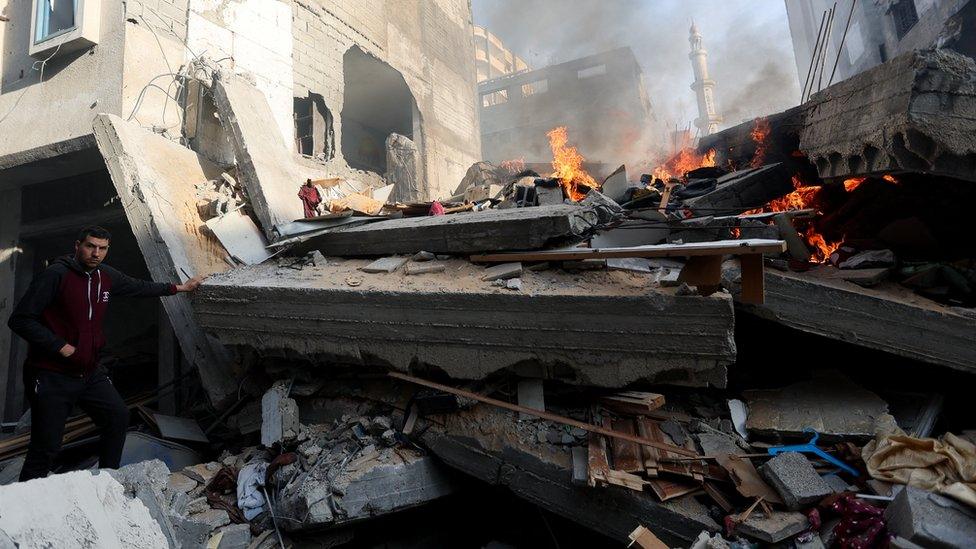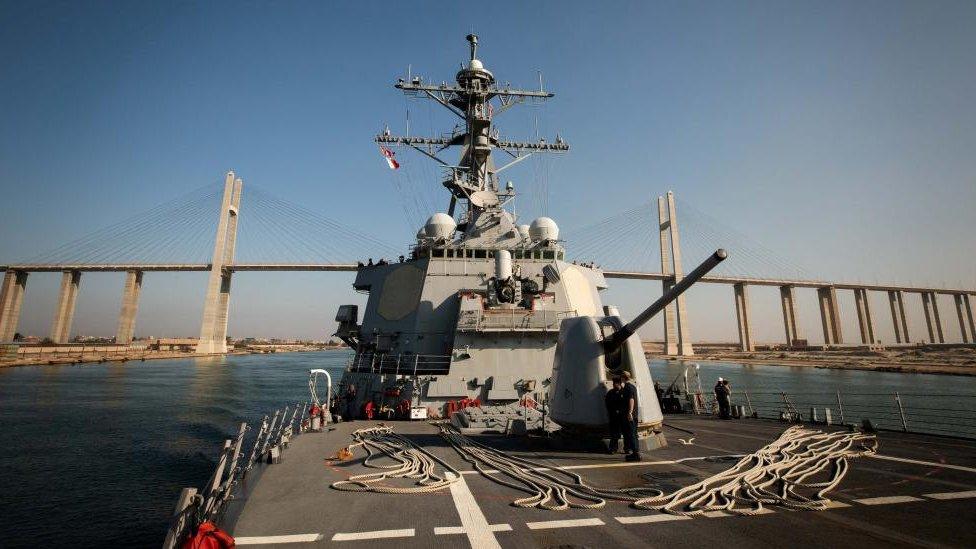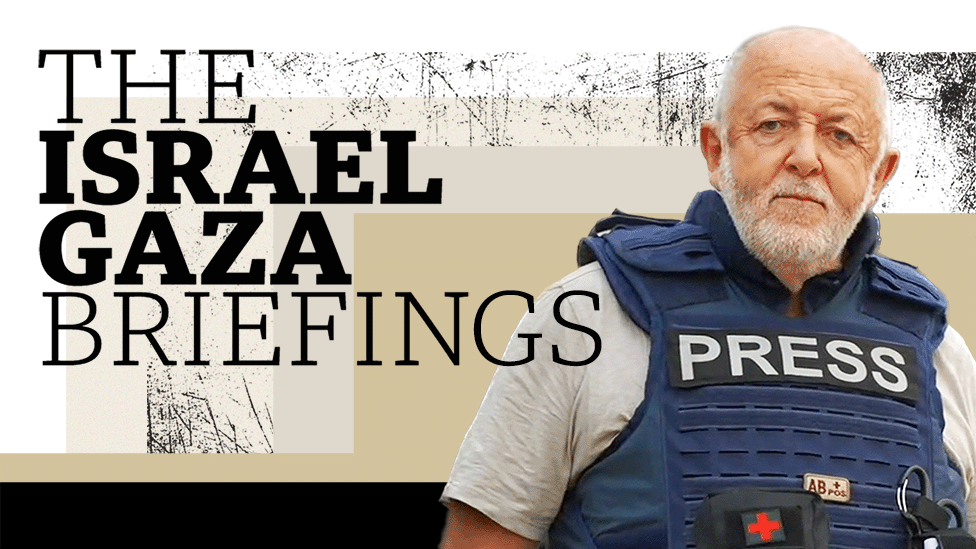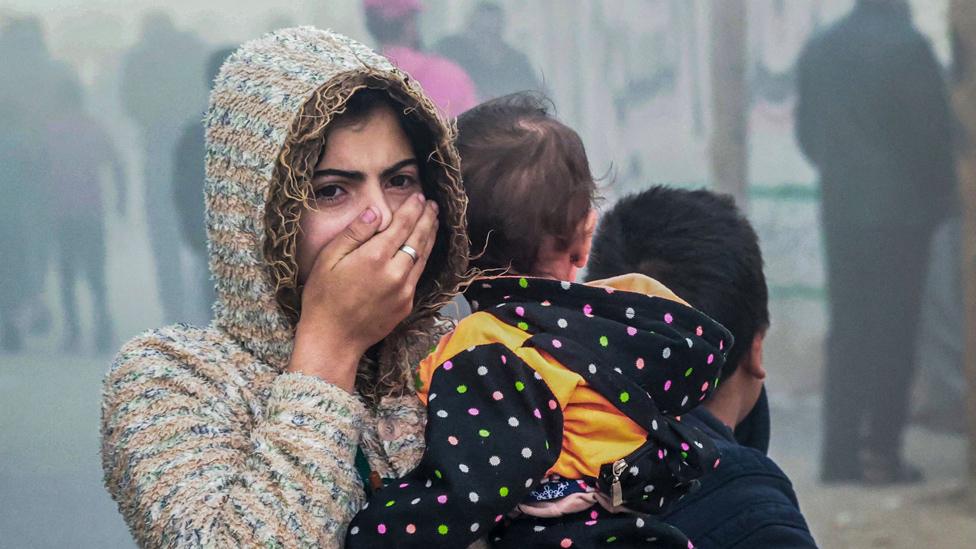Israel orders evacuations from city in south Gaza as offensive widens
- Published

Israeli air strikes have intensified in the south, including Khan Younis, since the collapse of a truce last Friday
Israel's military has ordered the evacuation of a fifth of the main city in southern Gaza, as it expands its ground offensive against Hamas.
A map showed six northern and central areas of Khan Younis where an estimated 167,000 people needed to leave.
Witnesses also reported seeing tanks to the east, and a doctor said a local hospital was overwhelmed by casualties.
In Gaza City, an unconfirmed report says 50 people were killed when Israeli air strikes hit two schools.
According to the Palestinian news agency Wafa, they died in schools sheltering displaced people in the city's Daraj neighbourhood.
Reuters news agency has said that the strikes are still to be independently verified and that the Hamas-run health ministry could not be reached for comment. The Israeli army said it was looking into the report.
Many of Gaza's 2.3 million residents are sheltering in the south after being previously ordered to leave the north.
The Israeli military said it would operate with "maximum force" in the south, as it had done in the north - where there has been widespread destruction over the past eight weeks.
Israel launched a full-scale campaign in Gaza in response to an unprecedented cross-border attack by Hamas gunmen on 7 October, in which at least 1,200 people were killed and about 240 others taken hostage.
Gaza's Hamas-run health ministry says almost 15,900 people have been killed in the territory since the war began, while the UN says a humanitarian catastrophe is unfolding.
A temporary ceasefire that lasted for seven days, which led to the release of 105 of the hostages and 240 Palestinians held in Israeli jails, fell apart on Friday.

The Israeli military said its operations in the south of Gaza would be of "no less strength" than those in the north
BBC Gaza correspondent Rushdi Abu Alouf, who is currently in Istanbul, says about 200 Israeli air strikes were reported overnight.
About 15 to 20 locations were targeted in and around Khan Younis, where the local population has swelled to as much as 1.2 million, according to local authorities. The central town of Deir al-Balah, about 8km (5 miles) to the north, was also bombed heavily.
Dozens of casualties, including women and children, arrived at Khan Younis's Nasser Hospital from different areas. Many were dead or seriously injured.
Mohammed Eid wiped tears from his bandaged face as he lined up among the mourners by bodies covered in white shrouds outside the hospital on Monday morning.
"We were sleeping safely, minding our own business. Suddenly, a bomb fell on us, and the whole building was destroyed," he told the BBC.
"My brother was torn into pieces, and so was his wife. My daughter was killed, and his daughters were killed, including his littlest. We can't find my mum, and my niece."

More on Israel-Gaza war
Follow live: Latest updates
7 October attack: Hamas planned rape as weapon of war - Israeli lawyer
Briefing: Bowen: US sets clearer red lines for Israel as ceasefire ends

Later, witnesses and local journalists in Gaza reported that they had seen Israeli tanks and armoured vehicles on the eastern outskirts of Khan Younis, by Abasan and Khuzaa, which is nearest to the boundary fence with Israel.
Moaz Mohammed told AFP news agency that he had seen tanks moving down the main north-south highway, Salah al-Din Road, which has been one of two Israeli-designated evacuation routes.
The tanks were "firing bullets and tank shells at cars and people trying to move through the area" between Deir al-Balah and Khan Younis, he said.
At the same time, the Israel Defense Forces (IDF) warned civilians to avoid a section of Salah al-Din Road in the same area, saying it now constituted a "battlefield" and was "extremely dangerous".
The IDF also posted a map, external that ordered residents of six northern and central neighbourhoods of Khan Younis - al-Mahatta, al-Katiba, Hamad, al-Satir, Bani Suheila and Ma'in - to leave immediately to "preserve your safety and security".

According to the UN, the marked area in Khan Younis was home to almost 117,000 people before the war. It also includes 21 shelters where 50,000 displaced people are currently living.
The map tells them to move to al-Fukhari, east of Khan Younis, and Rafah's al-Shaboura and Tal al-Sultan neighbourhoods, which are already overcrowded.
IDF chief spokesman Rear Admiral Daniel Hagari said in a statement that Israeli forces were continuing to operate with "maximum force against Hamas terrorists and infrastructure, while minimising harm to the civilians that Hamas places around them as shields".
"We are dropping leaflets with QR codes that opens a map guiding Gazans to safer areas. The map is divided into neighbourhood numbers indicating where civilians in a specific area should go to avoid being in the crossfire," he added.
The IDF has introduced the scheme because it is under heavy pressure from the US to protect civilians. However, our Gaza correspondent says he has spoken to Palestinians in the affected areas who are not aware of the map or cannot see it because there is no internet coverage.
"This is a joke, not a map, because we don't know where to go," a displaced person who was sheltering in Khan Younis told him.

Hospitals in the south are struggling to cope with the influx of wounded patients, who include children
Meanwhile, an orthopaedic surgeon at the European Hospital in Khan Younis told the BBC that it was overwhelmed by hundreds of wounded.
"It is chaotic - we can't absorb any more patients and they keep coming," Dr Paul Ley said. "We have more than 360 people on the operating list, which is impossible to deal with."
Dr Ley also said the hospital's corridors and grounds were full with 6,000 to 7,000 displaced people, some of whom were medics who had fled the north.
"Anaesthetics and pain killers are a big problem - we are running out slowly so we are lowering our safety standards. We never leave the hospital and our presence here has been notified to the Israelis, but shrapnel has reached the hospital," he added.
Médecins Sans Frontières also warned that more than 100 dead and over 400 injured people had arrived at the emergency room of Al-Aqsa hospital in Deir al-Balah in the last 48 hours, and that there was no space for new patients.
The UN said on Monday that four hospitals in the north were partially operating and admitting patients, with only limited services. The 12 hospitals in the south are partially functional, but bed capacity is only half what it was before the war and only one hospital can perform complex surgery.
Related topics
- Published4 December 2023

- Published2 December 2023

- Published1 December 2023

- Published1 December 2023
